Effective Strategies for Lawn Care Insect Control
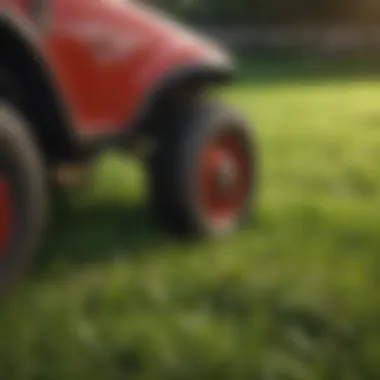
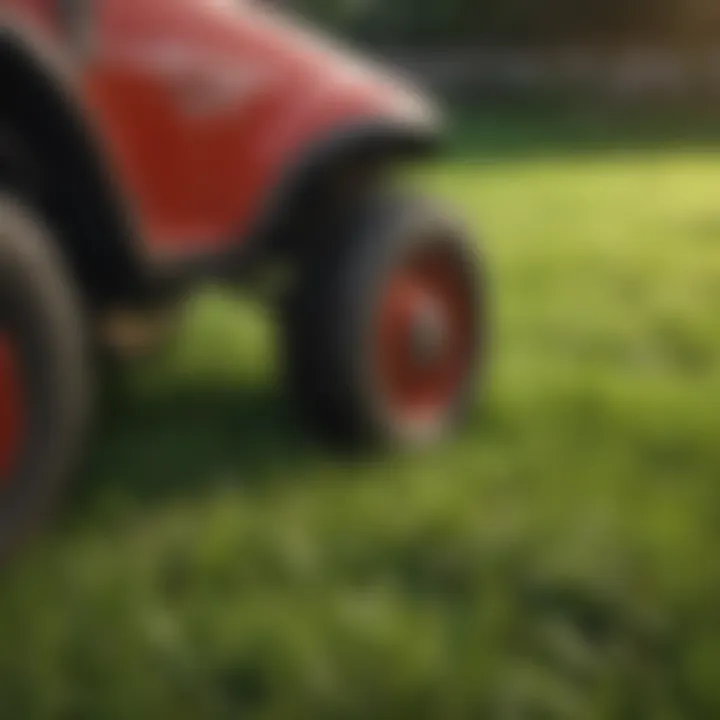
Intro
In any endeavor of nurturing a lush expanse of lawn, understanding the complex web of life that inhabits it is key. Lawn care is not merely about keeping grass green; it’s a delicate balancing act. On one hand, you have the aesthetic allure of well-tended grass, and on the other, the persistent threats posed by various insects. Having a handle on pest control is essential for any homeowner or lawn care enthusiast eager to maintain an ecosystem that thrives.
Insect pests can wreak havoc on a lawn, leading to unsightly damage and hindering growth. Therefore, it's not just about identifying these pests but also effectively managing them, fostering not only the health of the grass but also the surrounding soil and complementary flora and fauna. This requires a broad understanding of some foundational concepts in lawn care insect management.
Intro to Lawn Care Insect Control
Managing insects in your lawn isn’t just a chore; it’s a mission that can redefine the very essence of your outdoor space. The foundation of a thriving lawn doesn’t only rest on watering and mowing; it heavily relies on understanding the role insects play in the lawn's health. An effective insect control strategy is paramount since it influences not only the grass itself but also the ecosystem surrounding it. Proper pest management can mean the difference between a lush, vibrant lawn and a patchy, struggling one.
When you consider your lawn, think of it as an intricate tapestry, woven with various species of grass, soil types, and yes, insects. It's easy to overlook the smaller creatures working their way through the soil. You might be thinking, "What harm can a few bugs do?" Well, hold onto your hat because those seemingly insignificant insects can wreak havoc if left unchecked. A solid grasp of insect dynamics can empower any property owner to maintain not just aesthetics but also the health of the entire lawn ecosystem.
Importance of Insect Control in Lawn Health
Insect control is pivotal for several reasons. For one, pests such as grubs and chinch bugs can destroy the roots of your grass, leading to dead patches that are hard to revive. Here’s why keeping an eye on insects works wonders for your lawn:
- Grass Health: Different insects can cause damage in unique ways; some feed on grass blades, while others chomp on roots. If you’re not vigilant, the deception of "just a few pests" can result in widespread damage.
- Prevention of Secondary Issues: Allowing pests to thrive might invite other problems. This could be fungi or diseases that follow the damage caused by insects, ultimately making recovery much harder.
- Sustainability Awareness: Understanding the lifecycle and function of insects can lead to better decisions regarding pesticide use. It tops off a broader conversation about environmental stewardship, which resonates well with homeowners looking to minimize their ecological footprint.
- Cost Efficiency: Preventing an infestation is often less expensive than treating an established one. Keeping your finger on the pulse of lawn health saves you money in the long run.
"An ounce of prevention is worth a pound of cure."
To sum it up, lawn care insect control isn’t simply a nuisance; it’s a crucial aspect of sustaining the beauty and health of your turf. Engaging proactively means embracing strategies that cater to both the immediate aesthetics and long-term vitality of your lawn.
Understanding Lawn Ecosystems
Understanding lawn ecosystems is a pivotal aspect of effective insect control. A lawn is not just an expanse of grass; it’s a living environment teeming with various organisms that interact in complex ways. Grasping these interactions can lead to healthier lawns, more effective management strategies, and ultimately, a better understanding of how to mitigate pest-related issues.
Insects, in particular, play both supportive and destructive roles in these ecosystems. Recognizing their behaviors and interactions with other components of the lawn can aid homeowners and professionals alike in making informed decisions about pest control.
Major Components of Lawn Ecosystems
Every lawn comprises several integral components that contribute to its health:
- Soil: Serving as the foundation, healthy soil provides nutrients and water to the grass. It houses a plethora of microorganisms that enhance fertility.
- Grass Species: Different types of grasses thrive in various conditions. Choosing the right species based on local climate and soil type is crucial.
- Insects: While some insects are pests, others are beneficial, aiding in pollination and decomposition, which enrich the ecosystem.
- Plants and Weeds: Weeds are often unwanted, but they can also play a role in biodiversity. Some can attract beneficial insects that help in controlling pests.
- Microorganisms: Beneficial bacteria and fungi within the soil work symbiotically with grass and roots to improve nutrient uptake.
Understanding these components allows for better management practices that enhance lawn health and optimize pest control measures.
Role of Insects in Lawn Ecology
Insects hold a dual status in lawn ecosystems: they can be both allies and adversaries. Their role is nuanced and worthy of examination.
- Beneficial Insects: Ladybugs, predatory beetles, and parasitic wasps can effectively suppress typical pest populations, such as aphids and caterpillars. Promoting their presence is essential for a balanced ecosystem.
- Decomposers: Certain insects assist in breaking down organic matter, returning nutrients to the soil, which ultimately supports grass health. Earthworms, for example, improve soil structure and aeration.
- Pest Species: On the flip side, specific insects like grubs and chinch bugs can wreak havoc on a lawn, causing stress and, if left unchecked, leading to significant damage.
In summary, a comprehensive understanding of insects' roles within the lawn ecosystem is vital. Strategies should not aim to eliminate all insects but to manage populations effectively, preserving beneficial species while curtailing harmful ones. This balance is at the heart of sustainable lawn care.
Identifying Common Lawn Insects
Understanding the various insects that can plague your lawn is essential for maintaining its health and appearance. When you become familiar with the common lawn insects, you empower yourself to take proactive measures against potential infestations. Ignoring the signs of these pests often leads to greater damage that could have been prevented. By zeroing in on their habits and lifecycle, you can recognize issues before they escalate into severe problems, safeguarding your investment in lawn care.
Grubs: The Hidden Threats
Grubs often play the sneaky role in the roster of lawn pests. These are the larval form of various beetles and can wreak havoc beneath the surface. They thrive in warm conditions and typically do their damage in the summer and early fall. If you notice irregular patches of brown grass that pull away easily from the soil, you might be dealing with grubs. They feed on the roots of grass, leading to distinct, patchy areas that can be very unsightly.
To combat these pests, it’s wise to check the soil a few inches down. You can easily spot grubs by digging up a small section. Look for them curled into a C-shape; they can be white or off-white, and about an inch long. The best defense against these hidden threats is to implement preventive treatments during their active periods and to keep your grass healthy and well-watered.
Chinch Bugs: Small but Destructive
Chinch bugs are minuscule, but don’t let their size fool you; they are one of the most destructive pests in turf management. These pests suck the sap from grass blades, leading to a condition known as "chinch bug dieback." This typically manifests as irregular patches of yellowing or browning grass. You might see these areas expand rapidly as the bugs reproduce and spread across your lawn.
Chinch bugs prefer hot, dry conditions, often infesting lawns with low moisture levels. To identify them, gently part the grass and look for the tiny black bugs, typically about the size of a pinhead, with distinctive white wings. A hot tip for homeowners is to conduct a “float test” by pouring soapy water over the affected area. Chinch bugs will float to the surface within minutes, giving you a better understanding of their presence and the urgency needed to manage them.
Billbugs: The Lawn's Silent Eater
Billbugs are another deceptive insect that can become a problem in lawns, often overlooked until significant damage occurs. They are most notorious for their larvae, which tunnel through the grass stems, compromising their integrity. The adult billbugs are recognized by their elongated snouts and brownish color, and while they can be hard to spot, their impact is evident.
Signs of a billbug infestation include grass that appears to wilt significantly, or patches that seem to die out despite regular watering. Check the stems of grass for larvae—if you find them boring into the stems, that’s a red flag. Early intervention is key. Practices such as maintaining good lawn vigor, proper watering, and avoiding over-fertilization can help minimize the attractiveness of your lawn to these silent eaters.
Protecting your lawn means maintaining a proactive relationship with your garden. Routine inspections can save you a headache down the road.
In sum, recognizing and correctly identifying these common lawn insects is pivotal. Implementing observations regularly can help ensure your lawn remains healthy and robust against these small but mighty adversaries.
Signs of Lawn Insect Infestation
Detecting signs of insect infestation in your lawn is a crucial step in maintaining its health. Ignoring early signs can lead to larger scale damage and potentially transform a thriving green space into a patch of unsightly brown. When you know what to look for, you'll be able to act quickly. The discussion here will focus on key indicators, both visual and the overall impact on your lawn's appearance, guiding you towards effective management strategies.
Visual Indicators of Insects
When pests invade your lawn, they often leave visual clues behind. Here are some common indicators that suggest an insect problem:
- Uneven Coloration: A healthy lawn generally exhibits a uniform shade of green. If you start to see patchy areas, it might be a sign of insects like chinch bugs or grubs. The grass may appear yellowish or brown in affected spots.
- Bite Marks: Small holes or irregular bite marks may indicate feeding activity. This is commonly seen in areas infested by billbugs.
- Droppings: Insect droppings can resemble tiny pellets on the lawn. Their presence can signal that your grass is being targeted by pests.
- Matted Grass: Sometimes, grass blades can appear flattened or matted. This can happen due to insects like armyworms that feed on the foliage, weakening the plant.
Accurately identifying these signs early on can save you a lot of effort later. Without prompt recognition, your lawn could slowly decline into a less appealing state.
Impact on Grass Appearance
The repercussions of an insect infestation extend beyond mere aesthetics. A lawn under siege shows visible despair that translates into an overall unattractive landscape. Here’s how the state of grass can be affected:
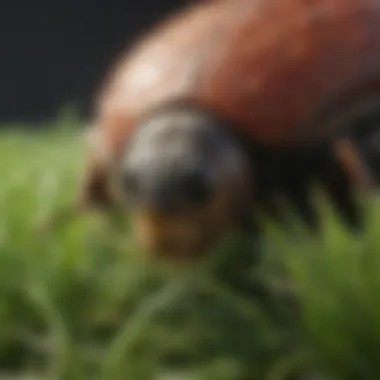
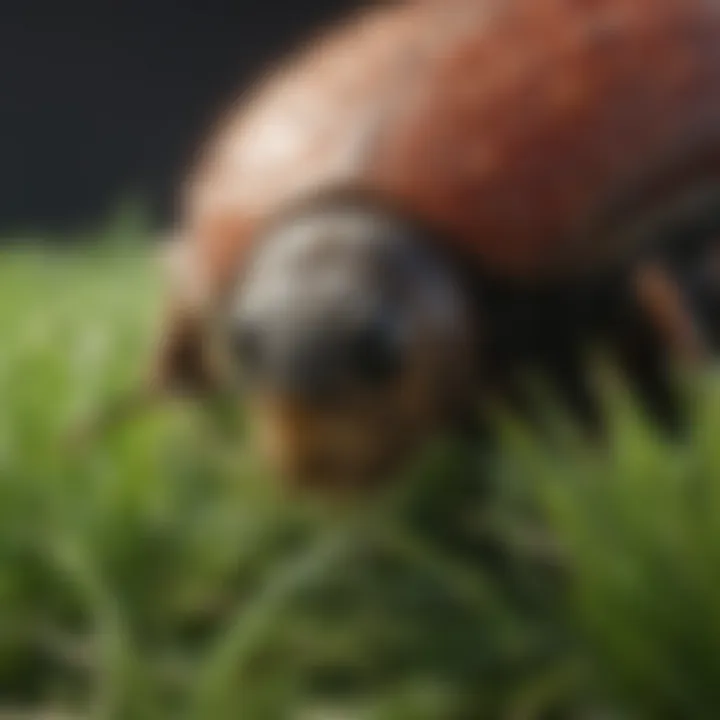
- Dullness: Healthy grass should shimmer with a vibrant green hue, but infested lawns often lack this luster. Where once there was vibrancy, now lies a tired, dull expanse.
- Spots of Thinning: Areas suffering from heavy insect activity will appear thin, making the yard look patchy and unkempt. In some cases, if left unattended, these vulnerable patches can die altogether.
- Wilting and Stress: Indeed, when grass is under stress due to pests, it may show signs of wilting. This can further complicate recovery if the pests are not dealt with promptly.
- Increased Weed Growth: As the grass weakens, weeds might take this opportunity to invade. Weeds establish more easily in unhealthy environments, creating an endless cycle of invasion.
In sum, the ongoing impact of pests is quite significant. Tending to these early signs not only restores aesthetic value but also promotes overall lawn health. Ignoring visual indicators can lead to a more severe infestation, ultimately complicating control efforts.
"A stitch in time saves nine" is a fitting adage here. Recognizing infestations early can drastically reduce the level of damage and stress on your lawn.
Ultimately, staying vigilant and knowing what to look for ensures that your lawn maintains its beauty and integrity over time.
Preventive Measures in Lawn Care
In the realm of lawn care, preventive measures stand as the first line of defense against invasive insect pests. Engaging in proactive strategies not only safeguards the health of grass but also enhances the ecosystem's resilience. Everything from soil quality to grass species can either predispose a lawn to insect issues or shield it from them.
Taking a preventive approach can save homeowners from costly replacements, extensive treatments, and the frustration of losing a beloved outdoor space. Focusing on prevention is indeed a no-brainer when considering the long-term vitality of your lawn. Here are a few fundamental elements to keep in mind:
- Establishing a healthy environment for grass is crucial.
- Strong lawns can resist pests, making it harder for them to take hold.
- Identifying potential threat factors allows for timely interventions.
Cultural Practices for Prevention
Cultural practices encompass various management strategies that promote a strong and vibrant lawn while simultaneously discouraging pest activity. These practices act on multiple fronts by ensuring a thriving environment for the grass and applying measures that limit pest prevalence. Here are a few cultural practices worth considering:
- Ideal Mowing Height: By keeping the grass at an appropriate height, homeowners can limit the opportunities for invasive pests to settle in. Short grass exposes soil and weakens the plant, while tall grass provides shade and maintains moisture levels.
- Watering Wisely: Overwatering can lead to root rot and invite pests. A consistent but moderate watering schedule is essential for maintaining grass health.
- Fertilization Practices: Regular application of organic fertilizers can improve soil structure, providing grass with critical nutrients and reducing pest attraction.
- Crop Rotation: It might seem strange on a lawn, but alternating grass types in patches can deter pest establishment.
These cultural practices contribute significantly to an effective preventive strategy, turning the tide in favor of the lawn rather than against it.
Soil Health and Its Role
Soil health is akin to the foundation of a house. A well-nourished, aerated soil serves as a robust starting point for any thriving lawn. Assessing soil conditions and amendments must be a priority for homeowners aiming for pest management.
Healthy soil encourages robust root systems, reducing the chances of pest infestations. Some important aspects include:
- pH Levels: Regularly testing and adjusting soil pH can promote beneficial microbial activity and improve nutrient uptake.
- Organic Matter: Compost and other organic materials increase soil health fostering an environment where good bugs thrive while bad ones dwindle.
- Soil Structure: Proper aeration practices prevent soil compaction, promote drainage, and encourage root development.
A great way to determine soil health is to seek professional advice or use a home soil test kit. Getting your hands dirty can pay off significantly when keeping pests at bay.
Choosing the Right Grass Species
Selecting the appropriate grass species for your specific location plays a critical role in lawn pest management. Every region comes with its own set of climatic conditions and pest challenges. Opting for grass species that thrive in your locale gives your lawn a fighting chance.
- Local Adaptations: Native grasses or varieties well-adapted to local conditions can not only resist pests but also limit the need for chemical interventions. For instance, turf-type tall fescue is often ideal for transitional climates, while Bermudagrass thrives in warmer regions.
- Diversity in Root Systems: Consider mixing different grass species to create a diverse lawn ecosystem that can prevent certain pests from overwhelming the area.
- Drought Resistance: Opting for drought-resistant varieties can minimize stress on the lawn and reduce the risk of pest infestations.
In summary, preventive measures encompass an understanding of cultural practices, maintaining soil health, and making informed grass species choices. The investment of time in these areas pays off in numerous ways, ensuring your lawn remains a beautiful and safe haven, free from pest disruptions.
Integrated Pest Management Strategies
Integrated Pest Management (IPM) is a sophisticated approach that combines various pest control methods to create a more balanced ecosystem. This strategy not only addresses the immediate threat posed by lawn insects but also considers the long-term health of the lawn and surrounding environment. Such a forward-thinking approach is essential in today's world, where the overuse of chemical pesticides can lead to adverse agricultural and environmental impacts.
In effect, IPM encourages the use of multiple tactics rather than relying on a one-size-fits-all solution. By incorporating environmental awareness into pest management practices, it minimizes health risks to humans and wildlife, while also promoting sustainable lawn care. Consider the following elements of IPM:
- Cultural Practices: Adjusting lawn care practices like watering routines, mowing heights, and fertilization can deter pest populations.
- Mechanical Control: Physical removal of pests, like grubs, or using traps, can be crucial in reducing pest numbers without resorting to chemicals.
- Biological Control: Introducing beneficial insects that naturally predates harmful pests introduces balance to the ecosystem.
The benefits of employing IPM strategies are manifold. For starters, they offer:
- Reduced Chemical Dependency: Relying less on pesticides can lead to healthier soil and greener lawns.
- Cost Efficiency: Over time, integrated strategies often reduce spending on chemicals and labor due to improved turf health.
- Enhanced Soil Quality: Maintaining a healthy balance of the ecosystem improves soil health, encouraging growth and resilience.
However, there are also considerations to keep in mind while implementing IPM:
- Knowledge Requirement: Familiarity with local insect populations, beneficial species, and environmental conditions is vital for a successful IPM plan.
- Time Investment: More observation time is needed to monitor pest levels and identify crucial thresholds for intervention.
Balancing those challenges with the advantages highlights IPM as a pivotal element within comprehensive lawn care.
Understanding IPM Principles
Understanding the principles of IPM is central to executing a successful lawn care strategy. The foundation of IPM rests on several core tenets:
- Prevention: The first line of defense against insect infestations is preventive action. This may include choosing disease-resistant plant varieties, rotating planting sites, or adjusting watering practices to reduce susceptibility to pests.
- Monitoring: Keeping an eye on pest populations is crucial. Regular lawn inspections can help detect pest problems early before they escalate.
- Threshold Levels: Knowing when to take action is equally important. Each pest has its own damage threshold, which is the precise point at which control measures should be initiated.
Applying these principles results in proactive rather than reactive lawn management, laying the groundwork for a thriving ecosystem.
Monitoring and Thresholds
Monitoring lawn conditions allows homeowners and care enthusiasts to gauge when intervention is necessary. Early detection of lawn insect issues saves time and resources, minimizing potential damage. This process might include:
- Regular Inspections: Make it a habit to check different sections of your lawn, especially areas where pests tend to thrive. Look for visual signs like unusual patches of discoloration or wilting grass, or the presence of insects themselves.
- Using Traps: Setting up traps helps in capturing adult insects for identification. Sticky traps or pheromone traps can be invaluable tools for monitoring pest populations.
Establishing pest thresholds involves determining the acceptable level of pest presence in your lawn. This consideration can vary based on specific lawn goals as well as the tolerance levels of different insects. When thresholds are exceeded, it’s time to take suitable action.
Biological Control Options
Biological control options are an essential component of IPM, focusing on the use of natural enemies to manage pests. This strategy often involves releasing beneficial insects that prey on lawn pests, thus promoting a more harmonious ecosystem.
Here’s a closer look at different biological control options:
- Predatory Insects: Ladybugs and lacewings are renowned for their ability to consume aphids and other pests. Introducing them can dramatically reduce pest populations without chemical intervention.
- Parasitic Wasps: Certain wasps lay their eggs inside host pests. Once hatched, these larvae consume the pest from within, effectively controlling its numbers.
- Nematodes: These microscopic roundworms can infest and kill grubs and other soil-dwelling insects, providing an underfoot solution for pest problems.
Implementing biological controls requires an understanding of local ecosystems and the right timing. Care should be taken to choose the most appropriate beneficial insect species based on the specific lawn’s needs and conditions.
Integrating these biological control measures enhances the diversity and resiliency of your lawn ecosystem, fostering a healthy environment for both grass and other flora.
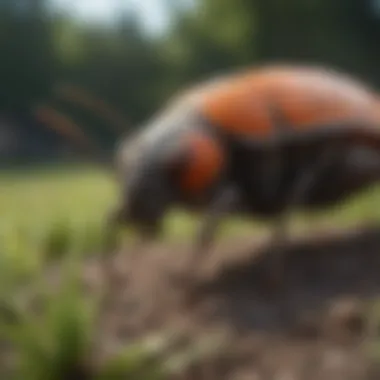
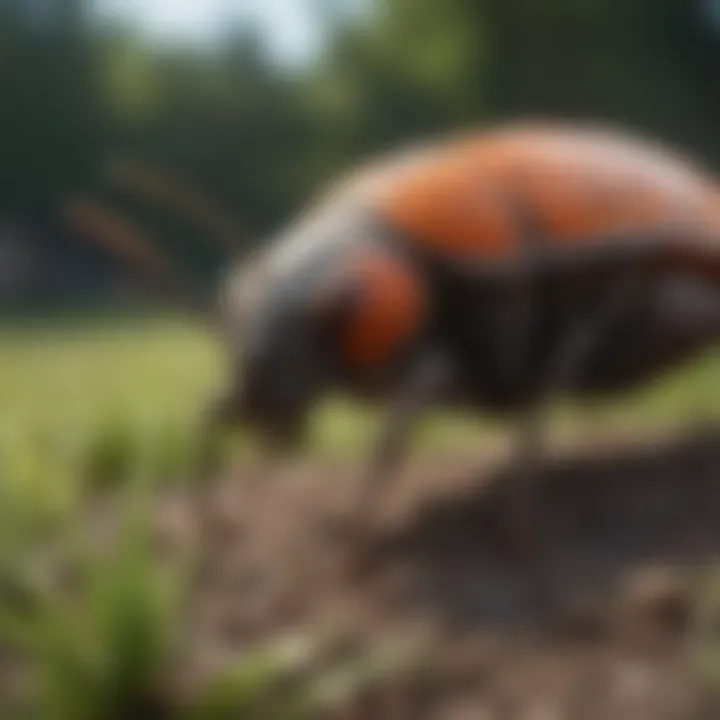
Chemical Control Options
In the realm of lawn care, chemical control options play a pivotal role, especially when pests threaten the vitality of grass ecosystems. While integrated pest management emphasizes a holistic approach, understanding chemical methods remains essential. These solutions can provide rapid results when infestations become overwhelming, but wielding them incorrectly can lead to unintended harm. The balance, therefore, lies in using chemicals judiciously and in tandem with other strategies.
Understanding Pesticides
Pesticides, broadly defined, are substances used to prevent, eliminate, or mitigate pests. They come in various forms, including insecticides for bugs, herbicides for weeds, and fungicides for fungal infections. Within the insecticide realm, there exists a spectrum — there are systemic options that absorb into plants, and contact options that require the pest to be directly hit.
When selecting a pesticide, it is critical to assess its specificity and impact on non-target species. Many homeowners believe that all pesticides are harmful; however, certain products can be tailored to target specific pests with minimal ecological disruption. For instance, neem oil, a naturally derived insecticide, effectively controls pests without adversely affecting beneficial insects.
"Not all pesticides are born equal; understanding their differences is the key to effective lawn care."
Application Techniques
Effective application of pesticides is not just about choosing the right product; it’s an art that demands precision and care. First and foremost, timing is crucial. Applying pesticides during early morning or late evening hours can maximize their effectiveness while minimizing harm to beneficial insects that are active during the day.
Here are some techniques to consider:
- Spraying: Directly targeting infested areas allows for localized control. For lawn applications, consider using a sprayer that gives an even coating.
- Granular Applications: These are often used for soil-dwelling pests like grubs. They can be spread over the lawn either manually or with a spreader, and they dissolve with moisture.
- Soil Drench: This method allows the pesticide to penetrate roots, absorbing them directly into plants. It is resource-intensive but effective against certain infestations.
Always adhere to label instructions,—this is not just regulatory but a vital practice to ensure safety and efficacy.
Ecosystem Considerations
While chemical controls can effectively curb pest populations, their use must be tempered with an awareness of broader ecosystem dynamics. The introduction of chemicals can alter soil health, harm beneficial insects, and even affect water quality through runoff. Bushy areas or flower beds close to the lawn can serve as refuge for beneficial insects, which can help keep pest populations in check naturally.
It’s crucial for any lawn care regime to keep these ecosystem considerations in mind:
- Choose targeted applications of pesticides rather than blanket treatments to minimize disruption to non-target organisms.
- Utilize barriers or vegetative buffers to prevent chemicals from entering waterways, which can lead to larger ecological effects.
- Continuously monitor insect populations and consider integrating beneficial insects to fortify natural resistance against pests.
Finding a balance between chemical intervention and sustaining the ecosystem can be challenging, yet it’s a commitment worth making for the health of not just your lawn, but the environment at large.
Fostering Beneficial Insects
Beneficial insects play a crucial role in maintaining the health of lawns and gardens. By fostering these helpful creatures, you can create a balanced ecosystem that naturally mitigates pest populations. This approach not only reduces the reliance on chemical interventions but also promotes biodiversity, which is essential for resilient ecosystems. Beneficials provide a layer of pest management that enhances the overall vigor of your lawn while contributing to its aesthetic appeal.
Types of Beneficial Insects
- Ladybugs: Often considered the poster insects for natural pest control, ladybugs are voracious eaters of aphids and other soft-bodied insects. Just one ladybug can consume up to 5,000 aphids over its lifetime.
- Lacewings: Known for their delicate, lace-like wings, these insects are excellent predators of caterpillars, aphids, and thrips.
- Parasitic Wasps: Although they may sound intimidating, these tiny wasps lay their eggs inside or on pest insects, which ultimately leads to the demise of the host. They are natural enemies to many common lawn pests.
- Nematodes: While often overlooked, beneficial nematodes are microscopic worms that can help control lawn grubs and other soil-dwelling pests.
- Predatory Mites: These small arachnids feed on various pests, including spider mites and thrips, offering yet another line of defense against infestations.
Creating Habitats for Beneficials
Creating conducive habitats for beneficial insects is as important as understanding their roles. Here are some effective strategies:
- Plant Diversity: Incorporate a wide variety of flowering plants. This diverse plant life can provide nectar, pollen, and habitats for both adult insects and their larvae.
- Native Plants: Use native plant species as they attract local beneficial insects and encourage their populations to thrive in your area.
- Shelter: Leave some areas of your lawn a bit untamed. Piling leaves or creating small brush piles can serve as natural shelters for beneficials as well as breeding sites.
- Water Sources: Introducing shallow water sources can help keep beneficial insects hydrated. A plant saucer with pebbles filled with water can do wonders.
- Reduced Pesticide Use: Minimizing or eliminating the use of broad-spectrum pesticides allows beneficial insects to flourish.
"In a world where pest outbreaks can seemingly come out of nowhere, creating a sanctuary for beneficial insects is akin to inviting Mother Nature’s own pest control team to the party."
By understanding the types of beneficial insects and implementing strategies to create their habitats, lawn enthusiasts can leverage natural pest control. This not only aids in maintaining lawn health and reducing chemical inputs but also fosters a thriving ecosystem where humans and nature coexist harmoniously.
Post-Infestation Recovery Tactics
After dealing with a bout of lawn insect infestation, it’s crucial to shift focus not just to recovery but also a deeper understanding of how such events can affect lawn health in the long run. Post-infestation recovery tactics not only involve assessing the damage done by pests but also implementing proper restoration methods to revitalize the affected areas. This section dives into the key strategies that contribute to effective recovery from pest-related damage.
Assessing Damage and Recovery
Once you've realized your lawn has faced an invasion, the first step is to assess the damage. Not all impacts are immediately visible, and sometimes, you might only notice browning grass or patches until you take a closer look.
- Visual Inspection:
- Soil Health Evaluation:
- Start by checking the lawn for any wilting or discoloration. Note any areas that are particularly sparse or unhealthy.
- Look beneath the surface; often, grubs can be found easily by pulling up a patch of grass; if it comes up with little resistance, you may have a pest problem.
- Take soil samples to evaluate nutrient deficiencies. Infestations can disturb the optimal soil balance, leading to further issues if left unaddressed.
- Observe soil moisture levels, as pests can affect the lawn's drought resilience as well.
Once you have a clear picture of the damage, it’s time to tailor your recovery efforts accordingly. Understanding the extent of damage and death, compared to what's still salvageable, can save you time and resources in the long haul.
Best Practices for Lawn Restoration
Restoring your lawn post-infestation is not simply about fixing the superficial damage; it’s about ensuring the underlying health of the lawn as well. Here are some effective best practices to consider:
- Fertilization:
- Reseeding and Overseeding:
- Aeration:
- Watering Techniques:
- Monitoring Pest Activity:
- Applying a balanced fertilizer can help replenish nutrients lost during the infestation. Opt for slow-release formulas to promote steady growth over time.
- If patches are dead, reseed those areas with grass varieties suited to your climate. For better results, overseed the entire lawn. This not only fills in bare spots but improves the lawn's overall density, making it less susceptible to future infestations.
- Aerate the lawn to relieve compaction and enhance oxygen exchange in the soil. This process promotes root growth, important for long-term recovery.
- Water deeply but less frequently. This allows grass roots to reach deeper into the soil for moisture, fostering resilience.
- After restoration efforts, keep an eye out for returning pests. Make use of traps or other monitoring methods to track any threats to the newly revitalized lawn.
It’s vital to recognize that recovery doesn’t happen overnight. The lawn might take time to rebound to its former glory, and sometimes it requires a bit of extra patience and care.
As you work through these recovery tactics, remember that your ultimate goals are not just a healthy lawn but maintaining the ecosystem that it supports. Ensuring that beneficial insects, soil microorganisms, and a healthy nutrient balance return to your lawn is essential for sustainable lawn care. Remember the profound words of the old adage: "An ounce of prevention is worth a pound of cure." Keeping your lawn healthy preemptively can save you from a multitude of headaches down the line.
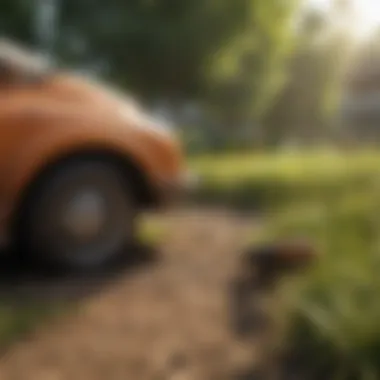
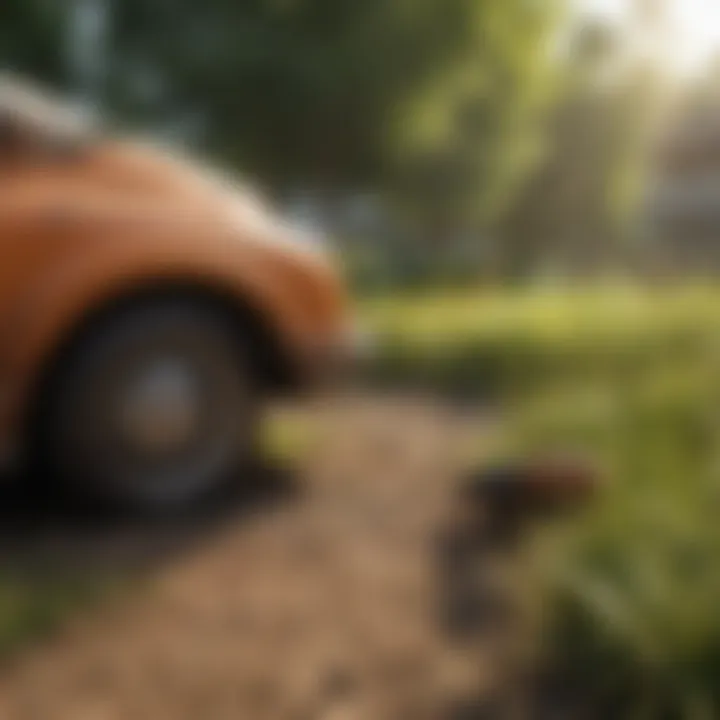
Seasonal Insect Control Considerations
Understanding the role of seasons in lawn care insect control can make or break a homeowner's efforts to maintain a thriving garden. Each season presents distinct challenges and opportunities for pest management, making it crucial to adjust strategies accordingly. With the whims of weather dictating the abundance of certain pests, being proactive rather than reactive is invaluable. This not only safeguards the lawn's aesthetic appeal but also promotes overall turf health.
Adjusting Strategies Based on Seasons
In landscaping, timing is everything. As the seasons change, so do the life cycles of lawn pests. Spring, for instance, is a time when insects like grubs emerge from their dormancy, ready to wreak havoc on tender grass roots. As summer approaches, chinch bugs may come to the forefront, seeking out water-stressed areas of the lawn.
Homeowners must adapt their management techniques throughout the year:
- Spring: Focus on early prevention strategies. This includes applying beneficial nematodes or targeted treatments for grubs. It’s best to be one step ahead before the pests settle in.
- Summer: Regular watering and proper mowing height can help create an environment less attractive to pests like chinch bugs. Monitoring should be frequent, as a quick response can mitigate damage.
- Fall: As temperatures drop, some pests like billbugs start reducing their activity. However, it's also the time to prepare for the next wave; applying dormant oil can help reduce pest populations before winter.
- Winter: While many insects may lie dormant, now is the time to prepare for the upcoming season, assessing tactics and making adjustments based on previous year experiences.
Common Seasonal Pests
Each season brings about a unique set of pests that can invade lawns. Recognizing these pests by their seasonal trends can help gardeners take timely action:
- Spring:
- Summer:
- Fall:
- Winter:
- Grubs: The larvae of beetles, grubs tend to chew on grass roots, leading to patches of dead grass. They become especially active as temperatures warm up, making early intervention crucial.
- Chinch Bugs: These tiny pests can quickly devastate sections of the lawn by sucking out juices from grass blades. Their populations explode during hot weather, so vigilance is key.
- Billbugs: During this period, these pests start to feed on the grass, leaving behind telltale signs like wilting grass and dying patches. Early detection through monitoring can save a lot of trouble later on.
- Ants: Although less commonly thought of as lawn pests, ants can disrupt the soil structure and their nests can sometimes attract other issues.
Monitoring these pests year-round allows you to implement an effective pest management strategy.
In short, understanding seasonal considerations in lawn care insect control not only helps to maintain a beautiful lawn but also supports a balanced ecosystem. Performance in the garden increases significantly when strategies are tailored to the seasonal dynamics of insect life.
Common Myths about Lawn Insect Control
Understanding common myths related to lawn insect control is essential for anyone looking to maintain a healthy lawn. These misconceptions can lead to ineffective treatments, wasted resources, and sometimes even more significant issues down the line. By debunking these myths, homeowners, farmers, and lawn enthusiasts can better equip themselves with knowledge that fosters a thriving turf. A well-informed approach nurtures both the lawn and the surrounding ecosystem, paving the way for sustainable practices.
Debunking Popular Misconceptions
There are several myths that tend to circulate among lawn care enthusiasts and professionals alike. Let's tackle some of them head-on:
- All insects are harmful: It's easy to assume that if an insect is on your lawn, it's a pest. However, many insects play a vital role in maintaining ecosystem balance. For instance, ladybugs feast on aphids, while spiders help keep other pests in check.
- A heavy application of pesticide is always necessary: Some people think that if a little pesticide works, a lot will work better. This isn’t the case. Overapplication can lead to resistance in pest populations and may harm beneficial insects. The key is finding the balance between effectiveness and safety.
- You should treat your lawn for insects whether you see damage or not: This myth can lead to unnecessary applications of chemicals. Monitoring the lawn and only treating when there is clear evidence of a pest problem is a more effective and environmentally friendly approach.
- Natural insect control is less effective than chemical treatments: While conventional pesticides can be powerful, many natural alternatives can be quite effective. Neem oil, for example, disrupts the life cycle of pests without the negative side effects associated with synthetic chemicals.
- Once pests are controlled, you can forget about monitoring: Pests are opportunistic, and neglecting to monitor your lawn can lead to a rapid resurgence of insect populations. Regular monitoring is necessary to ensure long-term health.
"Knowledge is the strongest weapon in managing lawn health, replacing myths with facts paves the way for greener pastures."
By addressing these myths, we open the pathway to better cultural practices. Implementing an effective lawn care program can ensure that your grass not only survives but thrives, supporting the larger ecosystem in which it exists. Fostering an awareness of these misconceptions provides a solid foundation for better management strategies that benefit both home lawns and the environment.
Future Trends in Lawn Care Insect Control
As we march further into the 21st century, the landscape of lawn care insect control is shifting. Homeowners and professionals alike are increasingly recognizing the critical role that innovative strategies and sustainable practices play in maintaining lawn health. The forthcoming trends aim to enhance pest management efficacy while upholding ecological integrity. Understanding these trends is essential as they offer a foresight into evolving techniques that make long-term lawn care more sustainable and efficient.
Emerging Technologies
Emerging technologies are revolutionizing our approach to managing lawn pests. Implementing advanced solutions not only improves effectiveness but also reminds us of the natural balance we aim to sustain. For instance, the use of drones for monitoring lawn conditions presents a commendable shift. These drones outfitted with specialized cameras can scan vast stretches of grassland to identify pest hotspots that an eye might miss.
Moreover, smart sensors can provide real-time data on soil conditions and insect populations. This data allows for precision management, where treatments can be applied selectively, minimizing waste and environmental impact. Another groundbreaking example involves the use of genetic engineering to produce grass types that are more resistant to common pests. Such innovations could significantly reduce the dependence on chemical treatments.
Sustainable Practices on the Rise
Alongside technological advancements, sustainable practices are gaining ground in lawn care insect control. There's a growing shift towards organic options that respect the ecosystem while effectively managing pests. Homeowners are turning to natural repellents and insecticidal soaps, misunderstanding their efficacy yet fully appreciating their gentler impact on the environment.
Another notable trend is the emphasis on biodiversity. By encouraging a variety of plant species, lawns become less hospitable to harmful pests while supporting beneficial insects. The promotion of native plants has been particularly well-received, as these species often require less water and fertilizer, thus promoting soil health.
Here are some sustainable practices that are making waves:
- Companion Planting: This strategy involves planting certain species together that naturally repel pests. For example, planting marigolds alongside grass can deter nematodes.
- Natural Predators: Introducing ladybugs and lacewings can help control aphid populations without resorting to chemicals.
- Regular Lawn Maintenance: Good practices such as aeration can enhance soil health and reduce the incidence of pest infestations.
"A stitch in time saves nine"—the goal here is preemptive management through these emerging technologies and sustainable practices.
Technological advancements and sustainable practices harmoniously complement each other in modern lawn care strategies. As we look ahead, the blend of innovation and ecological principles stands to shape a healthier and more resilient approach to managing lawn insects.
Culmination: Balancing Control and Ecosystem Health
In the grand scheme of lawn care, the art of balancing insect control with the overall health of the ecosystem stands as a vital cornerstone. It's a delicate dance where one misstep could lead to the unraveling of years of careful cultivation. The primary aim here is not simply to eradicate pests but rather to restore harmony within the lawn itself. By emphasizing integrated pest management (IPM) approaches, homeowners and professionals alike can foster an environment that promotes vitality and resilience, ensuring a lush, green lawn without undue disruption to the surrounding ecosystems.
A critical aspect of this balance involves understanding the relationships within the soil, plants, and insects. Each player contributes to a larger narrative where every action has a reaction, much like a well-functioning choir—when one voice goes out of tune, the entire harmony is affected. Being mindful of the interconnectedness of various lawn elements allows for more informed decisions on pest management techniques.
Benefits of Balancing Control and Ecosystem Health
- Promotes Natural Predation: By protecting beneficial insects that prey on lawn pests, the natural population dynamics shift, potentially reducing the need for chemical interventions.
- Sustains Soil Health: Healthy soils not only support grass growth but also help the ecosystem thrive, creating a more resilient lawn capable of withstanding pest pressure.
- Enhances Biodiversity: Maintaining a balance among insect populations contributes to a rich biodiversity, which is crucial for a healthy ecosystem.
- Long-Term Cost Effects: A well-managed lawn is less likely to suffer from severe pest infestations in the long run, leading to lower maintenance costs and fewer inputs.
Considerations in Achieving Balance
To attain this equilibrium effectively, a few considerations should guide homeowners:
- Regular Monitoring: Keep an eye on both beneficial and harmful insect populations.
- Diverse Planting: Mix varieties of grass and plants to create a more complex ecosystem, reducing the likelihood of pest outbreaks.
- Minimal Chemical Use: When pesticides are necessary, opt for targeted applications rather than blanket treatments, thereby minimizing impact on non-target species.
- Education and Awareness: Stay informed about lawn health, pest life cycles, and ecological impacts. Knowledge empowers better lawn care decisions.
"An informed gardener is a successful gardener; knowledge bridges the gap between chaos and control in a yard."
By advocating for strategies that underscore both control and ecosystem health, we cultivate a lawn that not only looks good but also functions well within its ecosystem. After all, a vibrant lawn is the product of balanced interactions, where each element plays its part without overshadowing another. This is a mindful approach, one that every agriculture farmer and lawn enthusiast can adopt to ensure not just the beauty of their lawn but the health of the entire ecosystem it resides in.
Reflections on Integrated Approaches
Looking back at the discussions throughout this article, it’s evident that integrated approaches aren't merely suggestions but necessary strategies for effective lawn care. By weaving together various methods—cultural, biological, and chemical—one can create a resilient management plan that adapts to the dynamic nature of ecosystems. The interdependence of these strategies allows for a nuanced approach, tailored to the specific needs of different lawns while respecting the broader ecological landscape.
Ultimately, it’s about understanding that every decision made impacts not just the garden but the environment beyond. When we strike the right balance in our control measures, we not only enhance our lawns but contribute to the well-being of the entire ecosystem, creating a legacy of sustainability for future generations.















